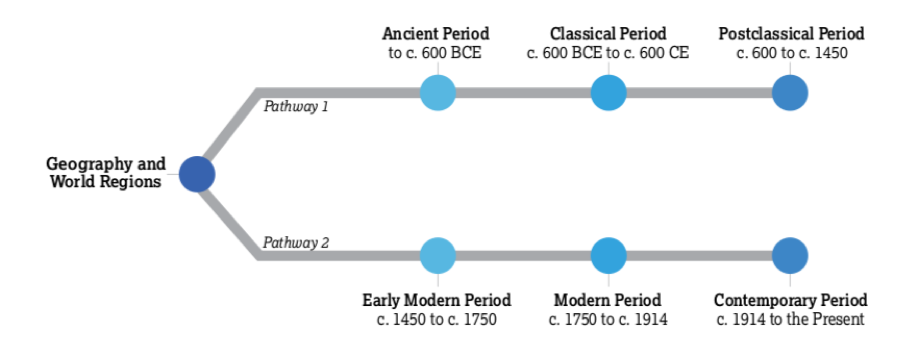Pre-AP World History and Geography
Focusing on concepts and skills with maximum value for high school, college, careers, and civic life, Pre-AP World History and Geography is built around three enduring ideas:
- History is an interrelated story of the world.
This course explores the structures and forces that reflect and shape the regions, communities, governments, economies, and cultures of humanity—helping students develop an organized, meaningful understanding of time and space. - History and geography are inherently dynamic.
As historians and geographers uncover new evidence, current assumptions are challenged, and previous arguments gain nuance and context. This course teaches students how to examine sources and data, establish inferences, and ultimately build and critique arguments. - Historians and geographers are investigators.
Pre-AP World History and Geography is designed as a disciplinary apprenticeship in which students learn through the process of discovery by applying the tools of historians and geographers.
Areas of Focus
The Pre-AP World History and Geography areas of focus prioritize the skills fundamental to the study of history and geography in high school, AP, and beyond. This gives students multiple opportunities to think and work like historians and geographers as they develop and strengthen these disciplinary reasoning skills throughout their education in history and the social sciences.
- Evaluating evidence: Students acquire knowledge by evaluating evidence from a wide range of primary and secondary sources.
- Explaining historical and geographic relationships: Students explain relationships among events and people by marshalling evidence for causation, comparison, and continuity and change over time.
- Incorporating evidence: Students demonstrate command of quantitative, qualitative, and spatial data by effectively incorporating them into written and oral arguments.
Unit Foundations
These themes are interwoven throughout all units:
- Humans and the environment
- Governance
- Economic systems
- Culture
- Society
Course at a Glance
Before implementing Pre-AP World History and Geography, schools select one of two pathways—allowing them to choose the modules that best fit their state standards and district course sequences.
- Both pathways begin with the study of geography and world regions.
- Pathway 1 focuses on developments in world history from the ancient period through c. 1450 CE.
- Pathway 2 focuses on developments in world history from c. 1450 CE through the present.
Each pathway has four main units: geography plus three units of history. Their key topics and recommended length are outlined here:
- Pathway 1
Unit 1: Geography and World Regions (~7 weeks)
Unit 2: The Ancient Period, to c. 600 BCE (~7 weeks)
Unit 3: The Classical Period, c. 600 BCE to c. 600 CE (~7 weeks)
Unit 4: The Postclassical Period, c. 600 CE to c. 1450 CE (~7 weeks)
- Pathway 2
Unit 1: Geography and World Regions (~7 weeks)
Unit 2: The Early Modern Period, c. 1450 to c. 1750 (~7 weeks)
Unit 3: The Modern Period, c. 1750 to c. 1914 (~7 weeks)
Unit 4: The Modern Period, c. 1914 to the present (~7 weeks)
Instructional Resources
These resources support teachers as they design instruction for each unit, but do not constitute a full day-by-day curriculum. They are intended to be used alongside local school or district materials to address objectives of the course framework.
- Source explorations: sets of curated primary and secondary sources with evidence-based questions and a culminating writing activity.
- Expanding essential knowledge resources: concise content summaries with graphic organizers to support student exploration.
- Lesson-planning resources: with instructional frames and a toolkit supports for instructional design and adaptations.
Assessments for Learning
Each unit contains:
- In-lesson formatives: short writing tasks that scaffold disciplinary thinking by exploring specific aspects of a key concept (scored by teachers).
- 2 learning checkpoints: short online assessments in which students interpret a range of sources and respond to questions targeting both disciplinary skills and key concepts from the unit (automated scoring and reporting).
- 1 performance task: a source-based analysis and evidence-based written response (scored by teachers, with provided scoring guidelines).
Beginning the 2025-26 academic year, we’ll be launching a Pre-AP Question Bank.
- Teachers will be able to author their own questions in the question bank and create their own assessments.
- Pre-AP Question Bank items can be used to create assessments of various lengths such as exit tickets, quizzes, semester tests, and more.
- Quizzes created with items from the Pre-AP Question Bank can be shared with other educators.
Because teachers will be able to create their own assessments in the question bank, the Pre-AP Final Exams will be retired.
